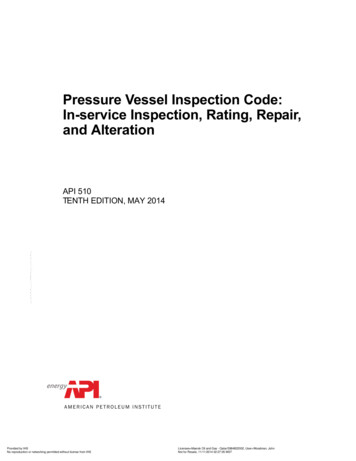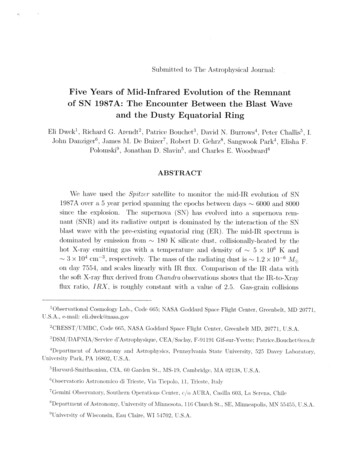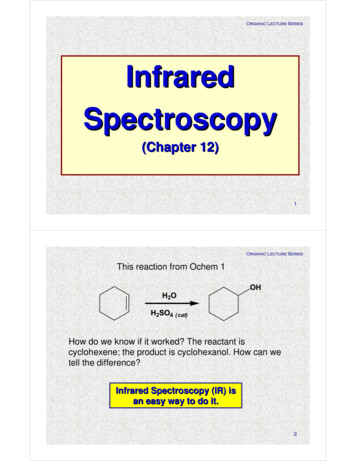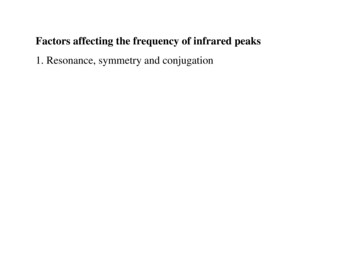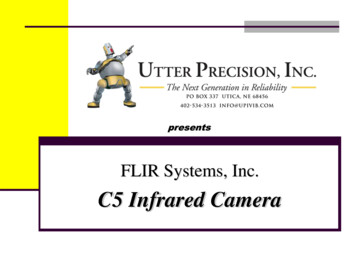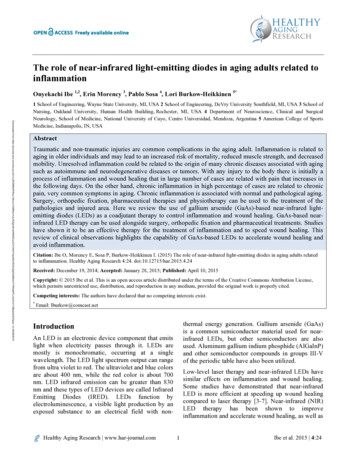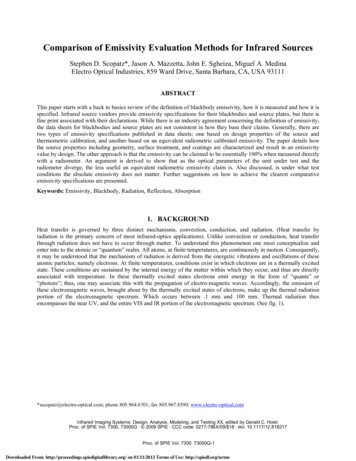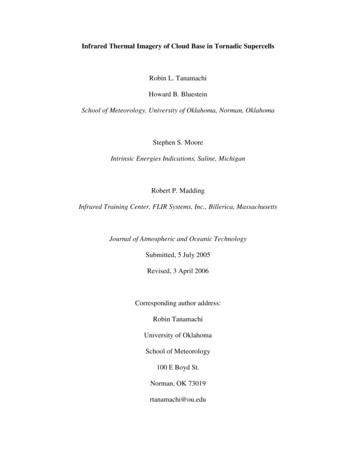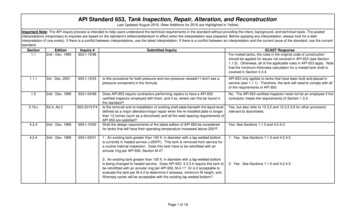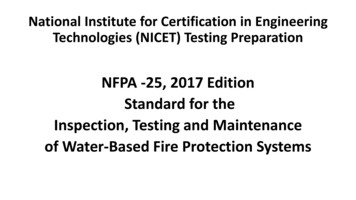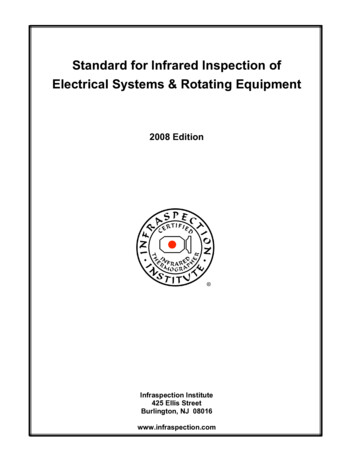
Transcription
Standard for Infrared Inspection ofElectrical Systems & Rotating Equipment2008 EditionInfraspection Institute425 Ellis StreetBurlington, NJ 08016www.infraspection.com
Standard for Infrared Inspectionof Electrical Systems & Rotating EquipmentForewordThis standard outlines the procedures and documentation requirements for conducting infraredinspections of electrical systems and rotating equipment. This standard covers an application which isboth art and science. This document assumes that the reader is generally familiar with the science ofinfrared thermography. It is not intended to be an absolute step-by-step formula for conducting aninfrared inspection.The use of this standard is not intended to qualify an individual using it to conduct an infraredinspection, or to analyze the resulting infrared data without formal training prior to its use.This document is intended to support infrared thermographers who have been professionallytrained and certified. It must be acknowledged and understood that the misinterpretation ofdata that can occur without proper training and experience cannot be avoided simply by usingthis standard. In no event shall Infraspection Institute be liable to anyone for special,collateral, incidental or consequential damages in conjunction with or arising from use of thisstandard.Other Infraspection Institute StandardsInfraspection Institute began publishing guidelines for infrared thermography in 1988. Since theirinitial publication, Infraspection Institute guidelines have been adopted by hundreds of companiesworldwide and incorporated into documents published by other recognized standards organizationssuch as the American Society for Testing and Materials (ASTM). Beginning in 2007, InfraspectionInstitute guidelines were renamed as standards to reflect their industry-wide acceptance and the bestpractices they embody.Several standards are available from Infraspection Institute. These standards cover equipmentoperation, temperature measurement, and specific applications. A complete list of currentInfraspection Institute standards may be found online at www.infraspection.com.Infraspection Institute standards represent the work of many practicing infrared thermographers andother experts. We thank them for their valuable contributions.Copyright 2008, Infraspection Institute1
Standard for Infrared Inspection ofElectrical Systems & Rotating Equipment2008 EditionTable of Contents1.0ScopePage 32.0Referenced DocumentsPage 33.0TerminologyPage 44.0Significance and UsePage 55.0Responsibilities of the Infrared ThermographerPage 56.0Responsibilities of the End UserPage 67.0Instrument RequirementsPage 68.0Inspection ProceduresPage 79.0DocumentationPage 810.0Delta T Criteria for Electrical SystemsPage 1011.0Absolute Temperature Criteria for Electrical SystemsPage 1112.0Delta T Criteria for Mechanical SystemsPage 1313.0Absolute Temperature Criteria for Mechanical SystemsPage 1314.0Documents Referenced by FootnotesPage 16Copyright 2008, Infraspection Institute 425 Ellis Street Burlington, NJ 08016This document may be reproduced for personal use and not for profit, without charge, provided youinclude all of the copyright and address information listed above. Failure to include this information withany reproduction is an infringement of the copyright and is subject to legal action and consequences.Copyright 2008, Infraspection Institute2
1.0Scope1.1This standard covers procedures for conducting infrared inspections of electrical systems and rotatingequipment.1.2This standard provides a common document for the end user to specify infrared inspections and for theinfrared thermographer to perform them.1.3This standard lists the joint responsibilities of the end user and the infrared thermographer that, whencarried out, will result in the safest and highest quality inspection for both.1.4This standard outlines specific content for documenting qualitative and quantitative infrared inspections.1.5This standard may involve use of equipment in hazardous or remote locations or in close proximity toenergized electrical equipment.1.6This standard addresses criteria for infrared imaging equipment, such as spatial resolution and thermalsensitivity.1.7This standard addresses meteorological conditions under which infrared inspections should beperformed.1.8This standard addresses operating procedures and operator qualifications.1.9This standard addresses verification of infrared data.1.10 This standard provides temperature limits for electrical and mechanical components and lubricants.1.11 This standard provides several means for prioritizing exceptions based on temperature.1.12 This standard does not purport to address all of the safety concerns, if any, associated with its use. It isthe responsibility of the user of this Standard to establish appropriate safety and health practices anddetermine the applicability of regulatory limitations prior to use.2.0Referenced Documents2.1Standard for Measuring and Compensating for Emittance Using Infrared Imaging Radiometers.Infraspection Institute, 425 Ellis Street, Burlington, NJ 08016.2.2Standard for Measuring and Compensating for Reflected Temperature Using Infrared ImagingRadiometers. Infraspection Institute, 425 Ellis Street, Burlington, NJ 08016.2.3Standard for Measuring and Compensating for Transmittance of an Attenuating Medium Using InfraredImaging Radiometers. Infraspection Institute, 425 Ellis Street, Burlington, NJ 08016.2.4NFPA 70B Recommended Practice for Electrical Equipment Maintenance. National Fire ProtectionAssociation, 1 Batterymarch Park, Quincy, MA 02169.2.5NFPA 70E Standard for Electrical Safety in the Workplace. National Fire Protection Association,1 Batterymarch Park, Quincy, MA 02169.2.6Occupational Safety and Health Standards for General Industry 29 CFR, Part 1910. US Department ofLabor. Occupational Safety & Health Administration, Washington, DC.Copyright 2008, Infraspection Institute3
2.7Occupational Safety and Health Standards for the Construction Industry 29 CFR, Part 1926. USDepartment of Labor. Occupational Safety & Health Administration, Washington, DC.2.8Level-l Certified Infrared Thermographer Reference Manual. Infraspection Institute, Burlington, NJ.2.9Level-ll Certified Infrared Thermographer Reference Manual. Infraspection Institute, Burlington, NJ.3.0 TerminologyFor the purpose of this standard,3.1End user - the person requesting an infrared thermographic inspection.3.2Exception - an abnormally warm or cool connector, conductor or component that may be a potentialproblem for the end user.3.3Infrared imaging radiometer (imaging radiometer) - a thermal imager capable of measuringtemperature.3.4Infrared inspection - the use of infrared imaging equipment to provide specific thermal information andrelated documentation about a structure, system, object or process.3.5Infrared thermal imager (infrared camera) - a camera-like device that detects, displays and recordsthe apparent thermal patterns across a given surface.3.6Infrared thermographer - a person who is trained and qualified to use an imaging radiometer.3.7Non-imaging radiometer (infrared thermometer) - an instrument that measures the average apparentsurface temperature of an object based upon the object’s radiance.3.8Qualified assistant - a person provided and authorized by the end user to perform the tasks required toassist the infrared thermographer. He/she is knowledgeable of the operation and history of equipmentto be inspected and is trained in all the safety practices and rules of the end user.3.9Qualitative infrared thermography - the practice of gathering information about a structure, system,object or process by observing images of infrared radiation, and recording and presenting thatinformation.3.10 Quantitative infrared thermography - the practice of measuring temperatures of the observedpatterns of infrared radiation.3.11 Rotating equipment - Stationary machinery or electro-mechanical devices that have rotatingcomponents.3.12 Standard - a set of specifications that define the purposes, scope and content of a procedure.3.13 Thermal imager - see Infrared thermal imager.3.14 Thermogram - a recorded visual image that maps the apparent temperature pattern of an object orscene into a corresponding contrast or color pattern.3.15 Thermographer - see Infrared thermographer.Copyright 2008, Infraspection Institute4
4.04.14.25.0Significance and UseThe purpose of an infrared inspection is to identify and document exceptions in the end user’s electricalsystem and/or rotating equipment.4.1.1In electrical systems, exceptions are usually caused by loose or deteriorated connections,short circuits, overloads, load imbalances or faulty, mismatched or improperly-installedcomponents.4.1.2For rotating equipment, exceptions are usually caused by friction due to improper lubrication,misalignment, worn components or mechanical loading anomalies.Providing opinions about the causes of exceptions, the integrity of the system, or recommendations forcorrective actions requires knowledge and skills beyond those of infrared thermography.4.2.1Infrared thermography will be presented as an inspection technique to gather and presentinformation about the system at a specific time.4.2.2Infrared thermography will not be promoted as a remedial measure.4.2.3An infrared inspection of an electrical system or rotating equipment does not assure properoperation of such equipment. Other tests and proper maintenance are necessary to assuretheir reliable performance.Responsibilities of the Infrared Thermographer5.1Infrared inspections will be performed when environmental and physical conditions such as solar gain,wind, surface and atmospheric moisture and heat transfer are favorable to gathering accurate data.5.2The infrared thermographer will have sufficient knowledge of the components, construction and theoryof electrical systems and/or rotating equipment to understand the observed patterns of radiation.5.3The infrared thermographer will use thermal imaging and/or measurement equipment with capabilitiessufficient to meet the inspection requirements.5.4The infrared thermographer will be accompanied by a qualified assistant who is knowledgeable of theequipment being inspected.5.5Unless he/she is a licensed electrician, professional engineer, or has other equivalent qualifications, theinfrared thermographer will not perform any tasks that are normally done by these personnel. Unlessso qualified and authorized by the end user, the infrared thermographer:5.5.1Will not remove or replace covers or open or close cabinets containing electrical equipment.5.5.2Will not measure electric loads of the equipment.5.5.3Will not touch any inspected equipment and will maintain a safe distance from suchequipment.5.5.4Will comply with the safety practices and rules of the end user and applicable safetystandards.5.6When performing quantitative infrared inspections, the infrared thermographer will assure that alltemperature-measuring equipment meets the manufacturers’ standard specifications for accuracy.5.7After repair, and when requested by the end user, the thermographer will reinspect each exception toassure that the problem has been corrected.Copyright 2008, Infraspection Institute5
6.0 Responsibilities of the End User6.1The end user will provide or help develop an inventory list of the equipment to be inspected in a logicaland efficient route through the facility.6.2The end user will provide a qualified assistant(s) who is knowledgeable of the operation and history ofthe equipment to be inspected. This person(s) will accompany the infrared thermographer during theinfrared inspection and, unless specified otherwise, will be qualified and authorized by the end user to:6.2.1Obtain authorization necessary to gain access to the equipment to be inspected and will notifyoperations personnel of the inspection activities.6.2.2Open and/or remove all necessary covers immediately before inspection by the infraredthermographer.6.2.3Close and/or replace these cabinet and enclosure covers immediately after inspection by theinfrared thermographer.6.2.4Assure that the equipment to be inspected is under adequate load, create satisfactory loadswhen necessary, and allow sufficient time for recently-energized equipment to produce stablethermal patterns.6.2.5Measure electric loads when requested by the infrared thermographer.6.3The end user takes full responsibility for consequences resulting from actions taken, or not taken, as aresult of information provided by an infrared inspection.6.4After repair, the end user will authorize reinspection of each exception to assure that the problem hasbeen corrected.7.07.1Instrument RequirementsGeneral7.1.1Infrared thermal imaging systems shall detect emitted radiation and convert detected radiationto a real-time visual signal on a monitor screen. Imagery shall be monochrome or multi-color.7.1.2Spectral Range: the infrared imaging system shall operate within a spectral range from 2 to14 µm. A spot radiometer or nonimaging line scanner is not sufficient.7.1.3The infrared thermal imaging system shall have a Minimum Resolvable TemperatureDifference (MRTD) of 0.3 C or less at 20 C.7.1.4Infrared equipment may be man portable or vehicle mounted.7.1.4.1For vehicle mounted equipment, care should be taken to ensure that equipment is mountedsecurely, will not interfere with the safe operation of the vehicle, and meets all applicableregulatory requirements.Copyright 2008, Infraspection Institute6
8.0Inspection Procedures8.1Equipment to be inspected shall be energized and under adequate load; ideally this is normal operatingload. For acceptance testing, higher loads may be warranted.8.2Subject equipment shall be externally examined before opening or removing any protective covers todetermine the possible presence of unsafe conditions. If abnormal heating and/or unsafe conditions arefound, the end user or qualif
Several standards are available from Infraspection Institute. These standards cover equipment operation, temperature measurement, and specific applications. A complete list of current Infraspection Institute standards may be found online at www.infraspection.com. Infraspection Institute standards represent the work of many practicing infrared thermographers and other experts. We thank them for .
